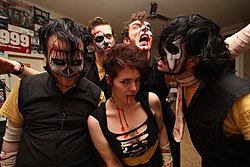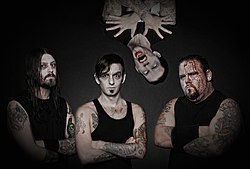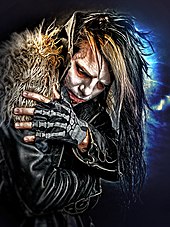Horror punk
|
Horror punk
|
|
| Development phase: | End of the 1970 year |
| Place of origin: | United States |
| Stylistic precursors | |
|
Hardcore punk , death rock , rockabilly , doo wop , garage rock , surf rock |
|
| Pioneers | |
|
Misfits , The Damned , The Cramps , TSOL , 45 Grave |
|
| Instruments typical of the genre | |
| Electric guitar - electric bass - drums | |
| Important local scenes | |
| United States , Germany , England | |
Horror Punk (also Horrorpunk ) refers to a music genre from a combination of in the strict sense musically hardcore punk and deathrock with the sound of rockabilly of the 1950s and the surf rock of the early 1960s is. Thematically and aesthetically, the genre is rooted in horror . As a formative and influential band, the Misfits contributed significantly to the genre of the genre in the late 1970s and early 1980s. However, it did not gain greater and lasting popularity until the mid-1990s.
The name itself has been in use since the 1980s and is sometimes used. a. 1985 mentioned in the Swiss fanzine Apocalypse Now in connection with the two-part compilation "Hell Comes to Your House" and the Californian horror-punk scene around bands like 45 Grave.
Origins
From 1977, the New Jersey- based Misfits began to combine the faster and more aggressive hardcore punk with elements of older music styles. Elements of rockabilly found their way into the sound of the band, just as Singalong and Doo Wop shaped the singing of the group, especially singer Glenn Danzig . The Cramps , which operated from New York, were created around the same time . Their musical style also merged different soundscapes from the 1950s and 1960s with punk rock and garage rock to create their own style. What both groups had in common was the ironic thematic and visual focus on B-movies , horror trash and pulp magazines .
B-movie and horror themes, however, were not a unique selling point of the punk scene on the US east coast. At that time, death rock emerged on the west coast, which arose from post-punk and developed parallel to British gothic punk . In contrast to this, however, death rock was strongly influenced by hard rock . This genre developed in different directions from the early 1980s. While some bands like Christian Death gradually developed the genre further, as a counterpoint to British Gothic Punk, others like 45 Grave remained rooted in punk rock, but now increasingly rely on Halloween and horror aesthetics and ironic horror topics and trash in the lyrics.
Old universal monster films with Boris Karloff or Bela Lugosi and the general aesthetics of horror trash played a major role, both visually and lyrically, for these horror punk trailblazers and set them as the opposite of gothic punk: "Trash instead of romance, leather instead of velvet" is controversial, whether the song "Monster Mash" ( Bobby Pickett and the Crypt-Kickers ), written in 1962 by Boris Karloff imitator Bobby Pickett and Leonard Capizzi , can be seen as a forerunner of horror punk. There is no question that stylistic overlaps exist. In addition, a number of horror punk bands covered this piece. Both the various cover versions and the 1962 original are very popular. There are also obvious parallels to Screaming Lord Sutch , who with songs such as Jack the Ripper (1963), Dracula's Daughter (1964) or Murder in the Graveyard connected contemporary pop and rock 'n' roll thematically and visually with horror themes, as well as with Ballads to so-called "Teenage Tragedy Songs".
Further development
After the dissolution of the Misfits as the essential founder of horror punk, the genre apparently "dormant" for years from the mid-1980s. Exceptions were the Canadian formation Forbidden Dimension , active since 1988 , which is revered by genre fans today as much as the Misfits, as well as the Groovie Ghoulies , which had been active since 1983 , both of which only gained popularity later.

The re-establishment of the Misfits in 1995 gave the genre new impetus. The Misfits benefited from their rise to the status of a cult band and their popularity only increased after the dissolution, which far exceeded the actual importance of the group until 1983. Paul Doyle Caiafa , longtime guitarist with the Misfits, commented on this in 2009: “In the old days we played concerts in front of 50 people, a maximum of 100. The Misfits weren't nearly as big as everyone thinks today. We only played about 60 gigs at all. Sure, we always gave it our all and over time we became better known. But before more happened, we broke up in 1983. When we came back in 1996, we didn't even realize that the Misfits had become so legendary. "
It was only from the mid to late 1990s that the popularity of horror punk increased rapidly. Numerous new bands, especially in the USA, are strongly oriented towards the Misfits. Wilms noticed great interest in Germany from 1999 onwards, which gained further popularity through the establishment of the horror punk label Fiendforce Records in 2003, which established the genre. This published two compilations under the title "This is Horrorpunk", which contributed to the popularity of the genre, especially in Germany. As a matter of fact, Germany developed into a center of horror punk from 2000, alongside its country of origin, the USA. Thorsten Wilms, singer and front man of the German music group The Other , described Germany as the "Mecca of the horror scene". Although most of the bands come from the USA, the largest fan base is here. He cites a long horror tradition in Germany as reasons, for example with the horror novel in the 18th century or the expressionist horror silent film of the 1920s, and generally the German preference for morbid art. Argyle Goolsby , former singer and bassist with Blitzkid , the main representative of the genre in the USA at the time, made a similar statement in a conversation with the Austrian music magazine Mulatschag . But despite this boom in the genre in Germany and Europe until 2010, which of course remained in the underground , it then largely dried up again. Many European bands disbanded, are inactive or turned to other directions, the Fiend Force label closed its doors in 2014. Singer Lon, from the German band The Fright, justified the musical change from horror punk to sleaze with changed taste and further ambitions. Thorsten Wilms from The Other, the most popular German music group in the genre, also explains the change in the band's soundscape towards metal: “You can't sound exactly like the Misfits on six albums and expect people not to be bored. Nevertheless, I see ourselves as a horror punk band in the sense that the genre has always connected different bands. " In this country, younger bands, like the Hellgreaser or Circus Rhapsody founded in 2011, are trying to counteract a stagnation of the genre. Since 2017 the "New Year's Horror - The Kiel Horror Punk Festival" has also been taking place. The festival with mainly German bands reached its fourth edition in January 2020.
The genre, on the other hand, was able to establish itself sustainably in the USA, where a lively horror point scene, its own festivals and record labels as well as many bands have established themselves.
The band Blitzkid, which was founded in 1997, changed from a group that was initially heavily inspired by Misfits into the most popular band in the genre with its own style and shaped subsequent young bands as much as earlier ones were shaped by the Misfits Argyle Goolsby commented on the state of the scene in the USA: “I see it positively that people are inspired by our music and that of other horror punk bands. That pleases me very much; I have already met many such musicians, so I know that they are very sincere. And of course we ourselves weren't the ones who invented horror rock. We came after the Misfits and others will come after us. At the moment it's really a real wave, I would say a tsunami. Horror-influenced music has never been so popular. "This is also confirmed by Wilms in 2015:" There are currently numerous horror-punk bands coming from the USA, it feels like never before, and a few are trying not to be like a Misfits cover band to sound. I like it! So the genre has a future, even if it is currently going through a short dry spell. "
Horror punk, horror rock and horror billy
Exact demarcation features of the genre are difficult to define. There is a lot of overlap with the Psychobilly . This came about at around the same time, as a result of the rockabilly revival, especially in England, shaped by bands like the Meteors or the Stray Cats as well as the Cramps . Like horror punk, this classic rockabilly combines with the fast and aggressive style of playing punk rock, although the emphasis is different, and combines this music with horror themes. The double bass , played with the slap technique , was not common in horror punk and has long been a distinguishing feature. However, many younger groups break genre boundaries and see themselves as rooted in both. Therefore, bands like Bloodsucking Zombies from Outer Space , the Koffin Kats , Rezurex , Kitty in a Casket or The Creepshow have meanwhile adopted the mixed name Horrorbilly .

As mentioned at the beginning, horror punk in the narrower sense offers a mixture of punk rock and the sound of the 1950s or early 1960s, with mostly melodic clear vocals. But there are bands that use horror themes and can be assigned to punk rock, but do not use rockabilly or doo-wop elements. Others use more metal elements and move in a certain gray area. An example of this, and often assigned to the genre, are the bands Wednesday 13 and the Murderdolls . With horror themes and black humor, musically, however, besides punk rock, clearly influenced by glam metal and sleaze . The albums also differ significantly from each other. It should be noted that front man Joseph Poole, alias Wednesday 13 , never used the term horror punk and added that he did not know the term until the band Frankenstein Drag Queens From Planet 13 broke up in 2004.
In many bands there are flowing transitions to other musical styles and subcultures, which is why some gothabilly , psychobilly and modern death rock groups are often also traded under the term due to their horror themes and close relationship to punk rock.
Thematic content
Horror B-movies and their representatives, such as Ed Wood, have a major influence on the scene and the lyrics of the pieces of music . The main basis is the time of the "Mashed Potatoes", cheaply produced horror films, such as the Hammer Film Studios with titles such as "Dracula and his brides" and "Dracula vs. Frankenstein ”, which was all about showing as many of the“ prominent ”monster figures as possible at the same time and luring the audience into the cinema with such a line-up. The texts mainly deal with relevant topics, such as classic movie monsters, vampires, ghosts, serial killers or murder and manslaughter. Nevertheless, one should not describe these representations as cruel or glorifying violence, but always as ironic and humorous. So the tenor of the music is always positive.
Thorsten Wilms described horror punk as the “perfect mixture of punk rock, rockabilly, gothic and heavy metal, coupled with the atmosphere of classic horror films and the trash factor of the 1950s horror comics. Horror punk is dark and subversive, but at the same time life-affirming and a guarantee for a good mood. "

Many bands sing about films, film monsters or topics from pulp and horror literature, but the genre also offers opportunities to subversively describe socially critical topics, comparable to the consumer criticism in George A. Romero's Dawn of the Dead , or personal experiences. For example, “Dusty” from the US horror billy band Stellar Corpses said: “In any case, there is always a connection between what is going on in life and what is reflected in horror. I think horror allows us to grapple with deeply rooted problems and issues, including the fear of death, of getting older, of being bonded and committed. ”Blitzkid also tried to tell short stories in their songs as well as personal ones To process experiences: “In all of our songs there is an emotional, personal content - regardless of whether it is obvious or not. If you look at our makeup, you will only see zombies. But if you pay attention to our texts, you will always find parallels to life and general things in this world. You just have to listen! "
Political statements are extremely rare in music. The horror punk is very closely connected with the psychobilly and like this largely apolitical.
Features of the scene

A common distinguishing feature is the mascot carried by the Misfits, the Crimson Ghost , a ghost wrapped in a hooded cloak or a stylized skull. This was originally a character from the horror series " The Man with the Death Mask " from 1946. The Misfits also created the so-called "Devillock", a long, extreme version of the Eddie Munster haircut, which is the trademark of the band and therefore of many fans was adopted, although today it is often viewed as a cliché.
As a proper name Horror punks often use the term Fiend to German about fiend or devil. The horror point scene also includes rockabillies and psychobillies as well as members of the black scene . The exterior thus corresponds to the appearance of these subcultures (e.g. the Greaser style), but bears significantly darker features. The typical horror punk outfit is often more colorful, but less embellished with accessories than with a modern goth . Allusions to the death rock scene are often evident in female horror punks. The spectrum is broad, but it never comes close to the "dirty" style of some punks .
Typical appearance:
- black, often worn leather jackets, black hoodies and, above all, black clothing
- Patches and badges from favorite bands
- T-shirts with a skeleton, horror comic or band motif
- Stretch jeans, leather pants or simple black pants
- Ranger boots, chucks or cowboy boots
- Rivets in various shapes
- Hairstyle as "devillock", long sidecut or undercut (usually "long front, short back", parted in the middle or flipped over to the side)
- Skeleton gloves
Halloween , October 31st , is a central theme and is celebrated excessively by horror punks with concerts and major events. In many regions of Germany, Halloween is the only opportunity of the year to take part in pure horror punk events. However , there is no reference to other public holidays such as Good Friday , the solstices or Corpus Christi . The reason for the special interest of horror punk in Halloween is obvious. Halloween in the USA is the day of witches, ghosts, dead, monsters and horror kitsch .
See also
Individual evidence
- ↑ http://www.rebelcircus.com/blog/hell-horror-punk/
- ↑ Urs Völlmin: Reviews , Apocalypse Now, issue 7, page 16, 1985
- ↑ Sonic Seducer, Special Edition 15 Years Sonic Seducer, 1/2010, page 88
- ↑ http://www.stylusmagazine.com/articles/weekly_article/england-fades-away-stylus-magazines-guide-to-goth.htm
- ↑ http://dailycollegian.com/2013/10/31/for-scary-kids-only-a-brief-history-of-horror-punk/
- ↑ Plastic Bomb No. 47, 2004
- ↑ http://vampster.com/artikel.php?id=18790
- ↑ Kin Kats - Music & Sexy SubStyle Magazine, Issue 7, April / May 2009, page 9
- ↑ http://www.ox-fanzine.de/web/itv/2129/interviews.212.html
- ↑ Sonic Seducer, Special Edition 15 Years Sonic Seducer, 1/2010, page 89
- ↑ a b FIENDFORCE RECORDS: Home of Horrorpunk Interview from March 25, 2006 on www.vampster.com
- ↑ http://www.laut.de/wortlaut/artists/b/blitzkid/biographie/index.htm
- ↑ https://www.youtube.com/watch?v=PPydgNqZ04M
- ^ Virus, issue 52, April / May 2013, page 56
- ^ Virus, issue 48, May 2012, page 548
- ^ Virus, Issue 47, June / July 2012, page 53
- ^ Virus, issue 66, August / September 2015, page 44, The Other - The fear is about
- ^ Virus, issue 63, February / March 2015, page 48
- ↑ http://www.kn-online.de/Nachrichten/Kultur/Blitzkritik-New-Years-Horror-Das-Kieler-Horrorpunk-Fest
- ↑ Ox-Fanzine, issue 95, April / May 2011, page 53
- ^ Virus, issue 34, April / May 2010, page 50
- ↑ http://www.huffingtonpost.com/zachary-ehren/blitzkid-music_b_1673781.html
- ↑ http://www.ksta.de/klangprobe/klangprobe-feat--hellgreaser-musikalischer-horror-mit-herz,16375040,20757918.html
- ↑ Kin Kats - Music & Sexy SubStyle Magazine, Issue 3, Aug./Sept. 2008, page 29
- ↑ Virus, issue 66, August / September 2015, pages 44 and 45, The Other - The fear is about
- ↑ http://www.rebelcircus.com/blog/hell-horror-punk/
- ↑ Archived copy ( memento of the original from March 8, 2016 in the Internet Archive ) Info: The archive link was inserted automatically and has not yet been checked. Please check the original and archive link according to the instructions and then remove this notice.
- ↑ Kin Kats - Music & Sexy SubStyle Magazine, Issue 9, Aug./Sept. 2009, page 19
- ↑ Dynamite !, issue 68, No. 1/2011, page 12
- ↑ Dynamite !, Edition 75, No. 2/2012, page 90
- ^ Virus, issue 41, July 2011, page 54
- ^ Virus, issue 48, May 2012, page 54
- ↑ Archived copy ( Memento of the original from March 5, 2016 in the Internet Archive ) Info: The archive link was inserted automatically and has not yet been checked. Please check the original and archive link according to the instructions and then remove this notice.
- ↑ http://dailycollegian.com/2013/10/31/for-scary-kids-only-a-brief-history-of-horror-punk/
- ↑ http://www.sparklingphotos.de/interviews/3171-interview-2012-mit-rod-usher-the-other-horrorpunk-band-zum-album-the-devils-you-know
- ^ Zillo, issue 4/2011, page 128, Blitzkid - The saxophone of Edgar Allan Poe
- ↑ Kin Kats - Music & Sexy SubStyle Magazine, Issue 10, Oct./Nov. 2009, page 32
- ↑ http://oivision.de/interviews/index.php?act=view&id=65
- ↑ Sonic Seducer, Special Edition 15 Years Sonic Seducer, 1/2010, page 89


